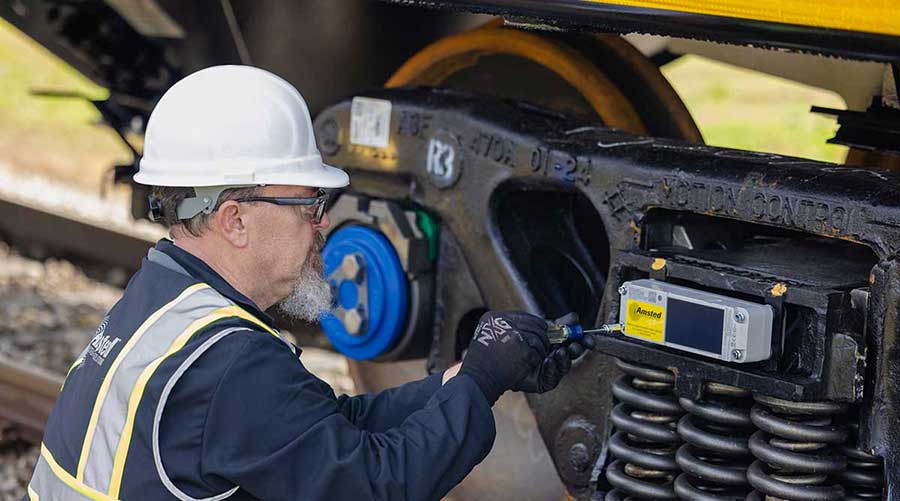Stay updated on news, articles and information for the rail industry
February 2014
Rail News: Rail Industry Trends
There's a lot at stake in the tank-car design discussions — by Toby Kolstad
— by Toby Kolstad
On Nov. 14, 2013, the Association of American Railroads (AAR) shocked the rail-car industry with a request to the U.S. Department of Transportation (USDOT) that it require all tank cars used to transport flammable liquids to meet certain design standards, including: full height head shields, high-pressure relief valves and thermal protection with an outer steel jacket. The AAR's response to the recent derailments involving crude oil from the Bakken Shale seemed to be "it was not our fault." The focus of the rail-car industry has remained fixed on this announcement ever since.
The Railway Supply Institute (RSI) weighed in with its own letter to the USDOT on Dec. 5, 2013, agreeing with most of AAR's suggestions with one notable exception: the required thermal protection and outer steel jacket. Moreover, the RSI suggested a 10-year grace period to allow owners of existing cars to retrofit their fleets to meet new design standards for new cars (except for the insulation and steel jacket), explaining that the retirements caused by a shorter deadline and the congestion in repair shops for cars to be refitted would result in severe car shortages.
This is not the first dust-up between the RSI and the AAR over tank car standards. After a particularly deadly derailment in 2005 involving chlorine gas (Graniteville), the AAR suggested that all tank cars moving toxic inhalation (TIH) gases built before 1989, when normalized steel was required for tank car shells, be retired within five years. Eventually, the USDOT issued regulations allowing existing TIH cars to continue in service until 2018, which will be around the 30th anniversary of the youngest cars in that group. Also, railroads and the rail-car industry agreed to intensify their efforts to improve tank-car safety, and agreed in 2011 on enhanced design standards for tank cars transporting flammable liquids. Now, the AAR wants to scrap those standards and impose new ones, even though the RSI claims that none of the consequential damage from the recent derailments involving tank cars would have been affected by the new rules.
Unlike the TIH matter that ultimately involved only 7,000 cars that had to be retired by 2018, the current problem involves tens of thousands of rail cars — estimated by various sources to be between 50,000 and 92,000 cars — that would cost from $30,000 to $67,000 each to modify. Consider just one car group: the 35,000 tank cars built between 2004 and 2008 to handle the ethanol that the government mandated to be mixed into the nation's gasoline supply. None of the cars have thermal jackets or high-pressure relief valves, so a minimal retrofit would cost at least $50,000 — provided all the cars could be insulated and jacketed, and still meet the AAR clearance limits. The leasing industry invested more than $3 billion to construct this fleet, and lease rates were based on a 30-year payback. Now, lessors are being asked to invest another $2 billion just to keep their cars in service, little of which could be recouped through higher lease rates because new cars costing much less eventually would be offered to lessees at much lower rates. Such are the perils of investing in freight cars!
There is one common denominator to all the tank-car derailment tragedies of late that has hardly been mentioned: Train speeds all exceeded 40 mph. High-speed derailments almost always involve dozens of cars piled into a very small space; in derailments at slower speeds, cars tend to stay coupled together and upright. Limiting the speed of trains with blocks of haz-mat tank cars to 25 mph would reduce the catastrophic consequences of derailments involving these cars by almost 100 percent. That would be far more effective than the 56.6 percent reduction estimated by the AAR's own research for the tank-car changes they have suggested, or the 37 percent reduction that would be achieved with RSI's recommendations. However, a 25 mph speed limit is as impractical to railroads as insulating and jacketing all existing tank cars in haz-mat service is for rail-car lessors.
Railroads and car owners have a lot to lose if a solution that's acceptable to both cannot be found. The RSI proposal would be a good starting point for a compromise, if timing were the only disagreement.
Toby Kolstad has been in the railroad industry for more than 40 years, with stints at the Illinois Central Gulf Railroad, Denver & Rio Grande Western Railroad, a car builder and lessor. Currently a consultant on rail-car matters and president of Rail Theory Forecasts L.L.C., he can be emailed at Tkolstad@aol.com.
(Editor's note: On Feb. 21, major U.S. freight railroads and the U.S. Department of Transportation (USDOT) announced the rail industry is launching a safety initiative aimed at instituting new voluntary operating practices for moving crude oil by rail. One of the steps: No later than July 1, they will operate trains moving 20 or more cars of crude that include at least one older DOT-111 tank car no faster than 40 mph in the federally designated 46 high-threat urban areas. In the meantime, they will continue to operate those trains at the industry-imposed speed limit of 50 mph.)
Keywords
Browse articles on tank cars tank car design AAR RSI Bakken Shale steel jacket Toby KolstadContact Progressive Railroading editorial staff.


 2025 MOW Spending Report: Passenger-rail programs
2025 MOW Spending Report: Passenger-rail programs
 Gardner steps down as Amtrak CEO
Gardner steps down as Amtrak CEO
 Guest comment: Oliver Wyman’s David Hunt
Guest comment: Oliver Wyman’s David Hunt
 Women of Influence in Rail eBook
Women of Influence in Rail eBook
 railPrime
railPrime





